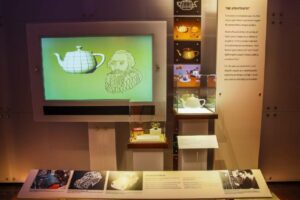 It’s just a 3D graphic of a porcelain teapot, but it became the legendary launching point for computer graphics throughout the world. The Salt Lake Tribune has written a history of the “Utah Teapot,” the digital computer model created in 1975 here at the University of Utah.
It’s just a 3D graphic of a porcelain teapot, but it became the legendary launching point for computer graphics throughout the world. The Salt Lake Tribune has written a history of the “Utah Teapot,” the digital computer model created in 1975 here at the University of Utah.
Martin Newell remembers that he and his wife, Sandra, weren’t in the habit of discussing his research when they sat for tea one weekend in 1975.
The British couple had moved to Salt Lake City so Newell could work under professor Ivan Sutherland at the University of Utah — the home of countless breakthroughs underway and yet to come in computer graphics and animation.
But Newell suspects his wife held the common opinion “that this whole thing about drawing pictures with computers was a very strange thing to do.”
She might have found it stranger still, then, that her suggestion over tea that day would lead to one of the most iconic images in the history of his field: a digital version of her white porcelain teapot.
Researchers were just discovering how to create realistic digital shapes and surfaces, the first steps toward the virtual worlds being created by students today in the U.’s top-ranked video game design program.
Using the era’s improved hardware, researchers were trying to create digital versions of all sorts of objects. Sutherland and his students had notably used flat-surface polygons to model his 1967 Volkswagen Beetle.
Newell wanted to show the usefulness of another method of modeling — Bezier curves — and his wife suggested he use their tea set.
He sketched and plotted a spoon, saucer and cup, too, but none turned out to have the combination of properties possessed by the Melitta teapot they had bought from a ZCMI department store.
Among them: it cast a shadow on itself, it was round but didn’t have overly complex curves, and had a concave space created by its handle.
When Newell shared his data set, he gave other graphics researchers a starting point to test their own ideas. A designer who wanted to explore how shading can make an object appear more real could just start shading the teapot — without the tedium of first envisioning and creating another effective model.
And it was a universal starting point — people anywhere knew what a teapot was supposed to look like, and they could compare their illumination, reflection, shading and other refinements to the efforts of others.
What followed for the teapot, Newell said, was “the 1970s version of something going viral.”
Click here to read the whole article at The Salt Lake Tribune.